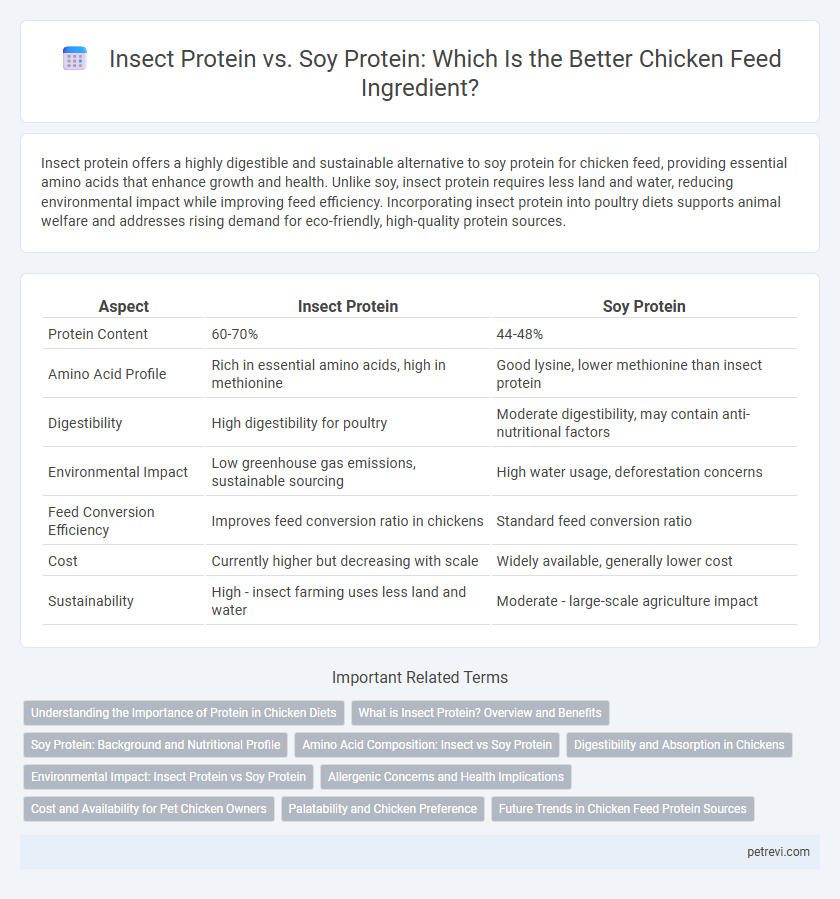Insect protein offers a highly digestible and sustainable alternative to soy protein for chicken feed, providing essential amino acids that enhance growth and health. Unlike soy, insect protein requires less land and water, reducing environmental impact while improving feed efficiency. Incorporating insect protein into poultry diets supports animal welfare and addresses rising demand for eco-friendly, high-quality protein sources.
Table of Comparison
| Aspect | Insect Protein | Soy Protein |
|---|---|---|
| Protein Content | 60-70% | 44-48% |
| Amino Acid Profile | Rich in essential amino acids, high in methionine | Good lysine, lower methionine than insect protein |
| Digestibility | High digestibility for poultry | Moderate digestibility, may contain anti-nutritional factors |
| Environmental Impact | Low greenhouse gas emissions, sustainable sourcing | High water usage, deforestation concerns |
| Feed Conversion Efficiency | Improves feed conversion ratio in chickens | Standard feed conversion ratio |
| Cost | Currently higher but decreasing with scale | Widely available, generally lower cost |
| Sustainability | High - insect farming uses less land and water | Moderate - large-scale agriculture impact |
Understanding the Importance of Protein in Chicken Diets
Protein is crucial for chicken growth, egg production, and overall health, making the choice of feed ingredients paramount. Insect protein offers a high-quality, sustainable amino acid profile that closely matches chickens' nutritional needs, often outperforming soy protein in digestibility and bioavailability. Incorporating insect protein can enhance feed efficiency and reduce environmental impact compared to traditional soy-based diets.
What is Insect Protein? Overview and Benefits
Insect protein, derived primarily from species like black soldier fly larvae and mealworms, serves as a sustainable, high-quality alternative to soy protein in chicken feed. Rich in essential amino acids, vitamins, and minerals, insect protein enhances poultry growth, feed efficiency, and immune response while reducing environmental impact due to its lower water and land requirements. This novel protein source combats soy-related supply chain pressures and supports circular economy goals by utilizing organic waste as feedstock for insect farming.
Soy Protein: Background and Nutritional Profile
Soy protein is a widely used ingredient in chicken feed due to its high-quality amino acid profile, especially rich in lysine and methionine, essential for poultry growth and development. It offers a balanced source of protein, with approximately 44-48% crude protein content, and contains important vitamins and minerals such as potassium, calcium, and B vitamins. The consistent availability, affordability, and proven digestibility of soy protein make it a dominant choice in poultry nutrition compared to emerging alternatives like insect protein.
Amino Acid Composition: Insect vs Soy Protein
Insect protein offers a superior amino acid profile compared to soy protein, particularly richer in essential amino acids like methionine, lysine, and threonine, which are critical for optimal chicken growth and development. Soy protein, while a common poultry feed ingredient, often lacks sufficient methionine, requiring supplementation to meet the nutritional needs of broilers and layers. The balanced amino acid composition in insect protein promotes better feed conversion ratios and enhances muscle development in chickens, making it a promising alternative protein source in poultry nutrition.
Digestibility and Absorption in Chickens
Insect protein exhibits higher digestibility and absorption rates compared to soy protein in chicken feed, due to its balanced amino acid profile and presence of chitin, which stimulates gut health. Studies indicate that chickens fed insect protein show improved nutrient uptake and feed conversion ratios, enhancing growth performance. Soy protein contains anti-nutritional factors such as trypsin inhibitors that can reduce protein digestibility and impair amino acid absorption in poultry.
Environmental Impact: Insect Protein vs Soy Protein
Insect protein production generates significantly lower greenhouse gas emissions and requires less land and water compared to soy protein, making it a more sustainable option for chicken feed. Soy cultivation often involves deforestation and high pesticide use, contributing to biodiversity loss and environmental degradation. Incorporating insect protein in poultry diets can reduce the environmental footprint of chicken farming while maintaining nutritional value.
Allergenic Concerns and Health Implications
Insect protein offers a hypoallergenic alternative to soy protein in chicken feed, reducing the risk of allergic reactions commonly associated with soy allergens like glycinin and beta-conglycinin. Studies show insect-based feeds improve gut health and enhance nutrient absorption due to chitin's prebiotic effects, promoting a robust immune system in chickens. Health implications include lower inflammation markers and decreased antibiotic use, positioning insect protein as a sustainable and health-conscious feed ingredient compared to traditional soy meal.
Cost and Availability for Pet Chicken Owners
Insect protein offers a sustainable and nutrient-dense alternative to soy protein for pet chicken owners, but often comes at a higher cost due to limited mass production. Soy protein remains widely available and more affordable, benefiting from established supply chains and large-scale agriculture. Cost-efficiency and accessibility make soy protein a preferred choice, while insect protein's potential depends on advancing production technologies to lower prices and increase availability.
Palatability and Chicken Preference
Insect protein offers higher palatability for chickens compared to soy protein due to its natural flavor and nutrient profile that closely mimics their natural diet. Studies show chickens demonstrate a marked preference for feeds containing insect protein, leading to increased feed intake and improved growth performance. Soy protein, while widely used, often requires additional flavor enhancers as its palatability is lower, potentially affecting feed conversion ratios.
Future Trends in Chicken Feed Protein Sources
Insect protein offers higher digestibility and essential amino acids compared to soy protein, making it a sustainable alternative in chicken feed formulations. Emerging trends emphasize the environmental benefits of insect farming, such as reduced land use and lower greenhouse gas emissions, aligning with the poultry industry's shift towards eco-friendly practices. Innovations in insect meal production and regulatory acceptance are accelerating its adoption, positioning insect protein as a key future ingredient in optimizing poultry nutrition and feed efficiency.
Insect Protein vs Soy Protein for Chicken Feed Ingredient Infographic

 petrevi.com
petrevi.com